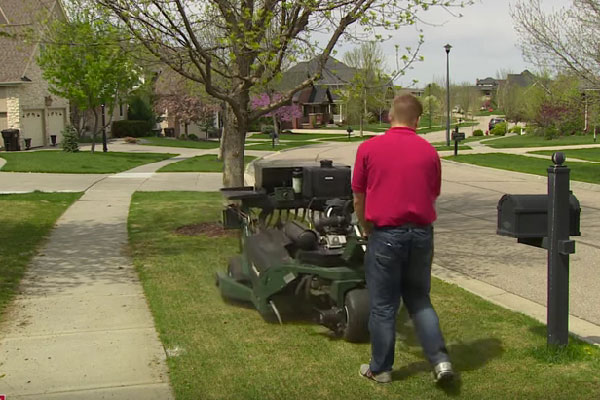The best time to seed cool season grasses, such as Kentucky bluegrass and tall fescue, is between August 15th and September 15th, so its time to start your site preparation.
Getting your seeding done as early as possible is really important, because each week of delay in seeding translates into 2-4 additional weeks required for the grass to mature. It is critical to seed tall fescue no later than mid-September. Tall fescue seedlings take a longer time to develop cold hardiness, so get your seeding done early.
Fall is, in fact, the best time of year for seeding lawns due to a combination of factors. First, there's less weed pressure than in spring, and late summer weather is less problematic during the soil preparation phase. Plus, the extended period of cool weather, usually with good rainfall, that occurs from September through late November is ideal for growth of cool season turfgrasses.
Getting Started
Total Renovation - If you need to renovate the entire lawn, start by killing the remaining grass and weeds with glyphosate (RoundUp), then wait for 10-14 days for the herbicide to take effect. Next, mow the dead vegetation as short as your mower will allow and move on to soil preparation.
Overseeding - If you just need to fill in thinned areas, and still have more than 50% good turf then overseeding is the answer. Skip the RoundUp, but mow the existing grass fairly short, 2.5 - 3 inches tall, to make soil preparation easier.
Soil Preparation - Prepare the seedbed through aerification, making at least 3 passes over the lawn. You need to produce lots of bare soil, so the seed can make contact with it. Watering the lawn area a day or two beforehand will make aerification easier and allow the machine to take deeper cores.
Fertilization - Nebraska soils are rarely low in phosphorus, but turfgrass seedlings do benefit from a starter fertilizer high in phosphorus at seeding. Once the area is prepared, apply a starter fertilizer totaling 1 to 1.5 lbs Phorphorus/1,000 sq.ft.
Phosphorus is the second number in the fertilizer ratio. For example, a 16-22-8 product contains 22% phosphorus. At 22% phosphorus, you would need to apply approximately 4.5 lbs. of product per 1,000 sq.ft. to supply 1 lb. phosphorus/1,000 sq. ft.
Spreading Seed
After preparing the area, use a drop spreader to apply the seed. Rotary spreaders are great for fertilizing, but not so great for seeding. Seed is too light to spread uniformly with a rotary spreader so purchase, rent or borrow a drop seeder. Divide the seed in half; apply the first half as you walk north to south, and the second half going east to west. This helps ensure even distribution.
Afterwards, rake the seed slightly to ensure good seed/soil contact. The full seeding rate for turf-type tall fescue is 6-8 lbs./1,000 sq.ft., and 2-3 lbs. for Kentucky bluegrass. When seeding into an existing lawn, the seeding rate can be cut in half.
Watering & Mowing
Irrigate the seeded area 2 to 4 times a day during the first two weeks, depending on temperatures. Keep the top 1/2 to 1 inch of soil moist as the seedlings germinate. Taper off your watering schedule as the seedlings develop. As they approach mowing height, reduce the number of irrigations to 2 to 3 per week, but water more deeply with each application to encourage deep root development.
Begin mowing as soon as possible. Mowing encourages tiller development, and helps new plantings thicken up quicker. It also keeps weeds under control while the new seedlings become established. Just be sure to sharpen your mower blade.
Dormant Seeding
If fall turfgrass seeding isn't possible for you, then consider dormant seeding. With this method, the area is prepared in late fall, late September through November, but the seed is not distributed until after the growing season has ended. Plan to spread the seed anytime from mid- to late November through March. The second publication below, Establishing Lawns from Seed, provided more information on dormant seeding.
For more information on lawn seeding, check out the following publication.
- Improving Turf in Fall, UNL Turfgrass iNfo
- Establishing Lawns From Seed, UNL Turgrass iNfo
- Overseeding Turf, Backyard Farmer Video
- Lawn Renovation Overview, Backyard Farmer Video

